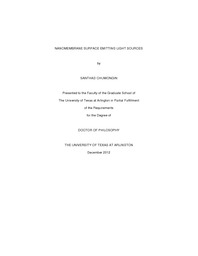| dc.description.abstract | Crystalline semiconductor nanomembranes (NM), which are transferable, stackable, bondable and manufacturable, offer unprecedented opportunities for unique electronic and photonic devices for vertically stacked high density photonic/electronic integration, high performance flexible electronics and flexible photonics. High quality single crystalline silicon NMs (Si NM) have been transferred onto various foreign substrates, such as glass and flexiblePolyethylene terephthalate (PET) plastics, based on low temperature transfer and stacking processes, developed by various groups. In the last few years, significant progress has been made by Ma's group on record high-speed flexible electronics, and high performance flexible Germanium (Ge) photodetectors, based on transferable Si/SiGe NMs. Many excellent results have also been reported by Lagally and Rogers's group on the unique electronic, photonic and thermoelectronic, and mechanical properties associated with this new class of inorganic flexible semiconductor membrane material systems. In this thesis, the design, fabrication and characterization of these following unique photonic devices, with focus on the NM broadband reflectors both on SOI and glass substrates, flexible crystalline InP NM LEDs arrays on PET substrate, and membrane reflector vertical cavity surface emitting lasers (MR-VCSELs) on silicon substrate, will be investigated in detail.viThe single crystalline silicon membrane reflectors (MR) based on Fano resonance or guided mode resonance (GMR) effect have been designed, fabricated, characterized, and compared their measured results with calculated ones and all of them agreed very well. Importantly, all of these MRs will be employed to replace distributed Bragg reflectors (DBRs) in the conventional InP-based VCSEL and provide a very compact resonant cavity for MR-VCSELs which will be discussed later.The flexible crystalline InP NM LEDs arrays for high performance flexible electronics and photonics have been experimentally demonstrated, transferred onto PET substrate based on low temperature transfer and stacking processes including frame-assisted membrane transfer process (FAMT), and both optically and electrically characterized.The III-V based VCSELs on Si substrate by transfer printing technique have been designed, fabricated, and characterized. The InGaAsP quantum wells embedded in a Si-MR cavity have been performed. Unlike the conventional DBR-based VCSEL, the ultra-thin DBR-free MR-VCSELs can be bonded or transferred onto Si substrate after finishing laser fabrication that offers a very simple and agile approach to large scale photonic heterogeneous integration. Unlocked constraints in lattice mismatches and thermal mismatches, moving forward to a wide range of applications in optoelectronic and photonic devices, and integrated systems. | en_US |


